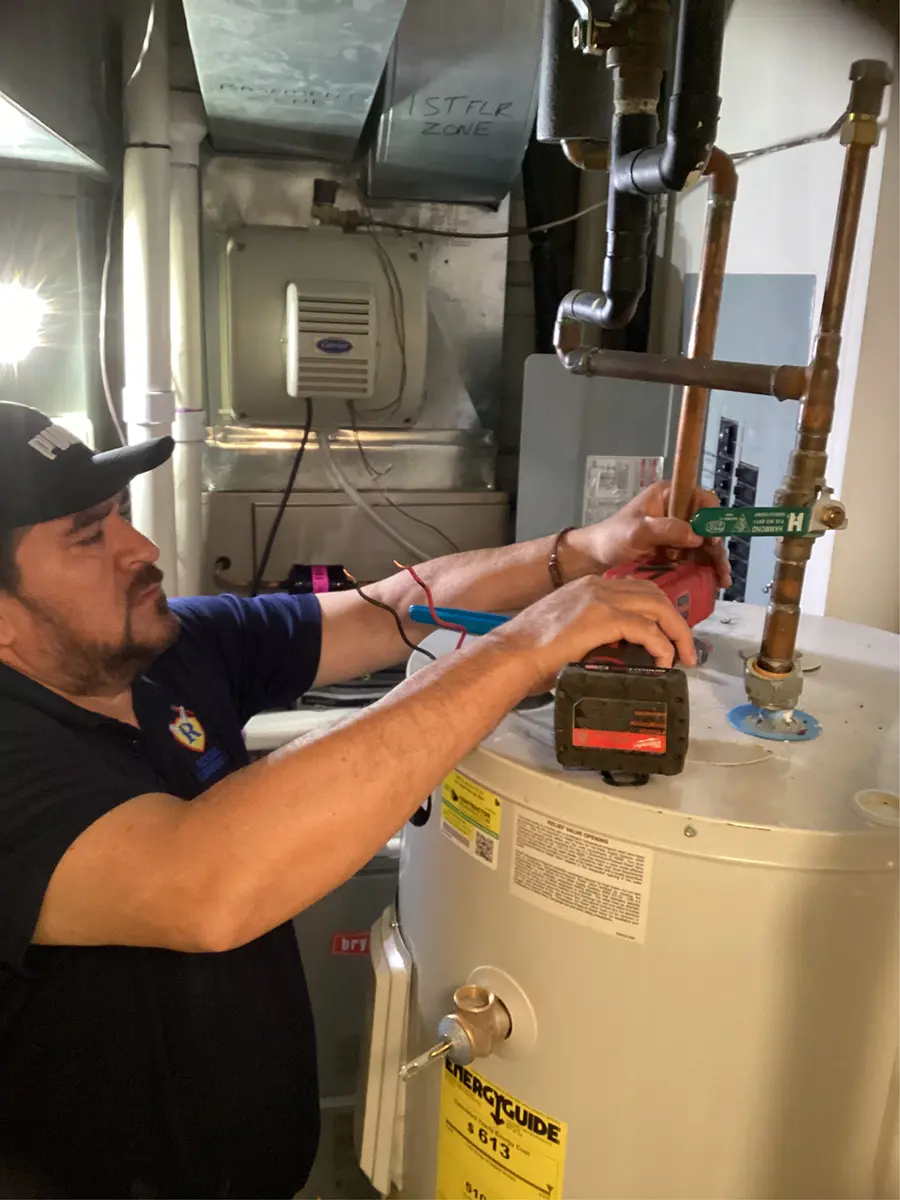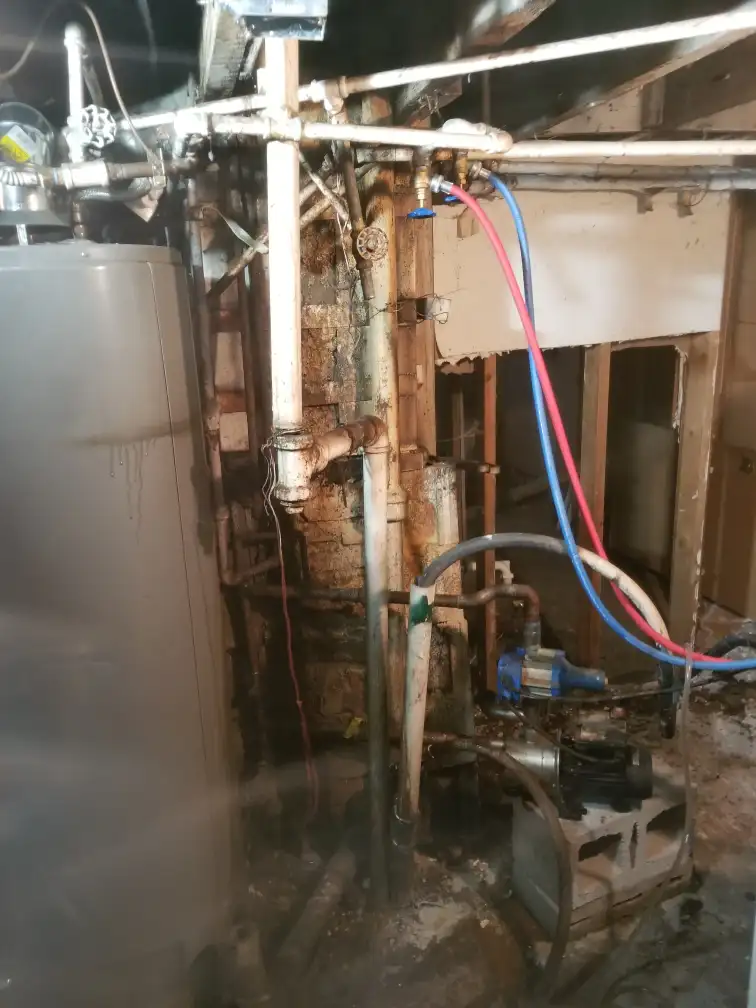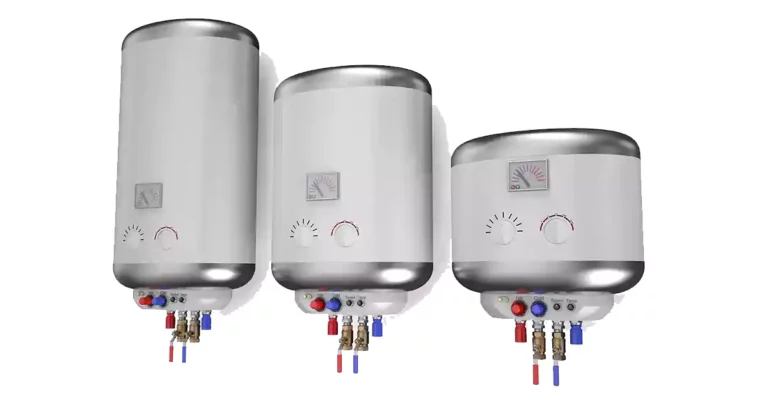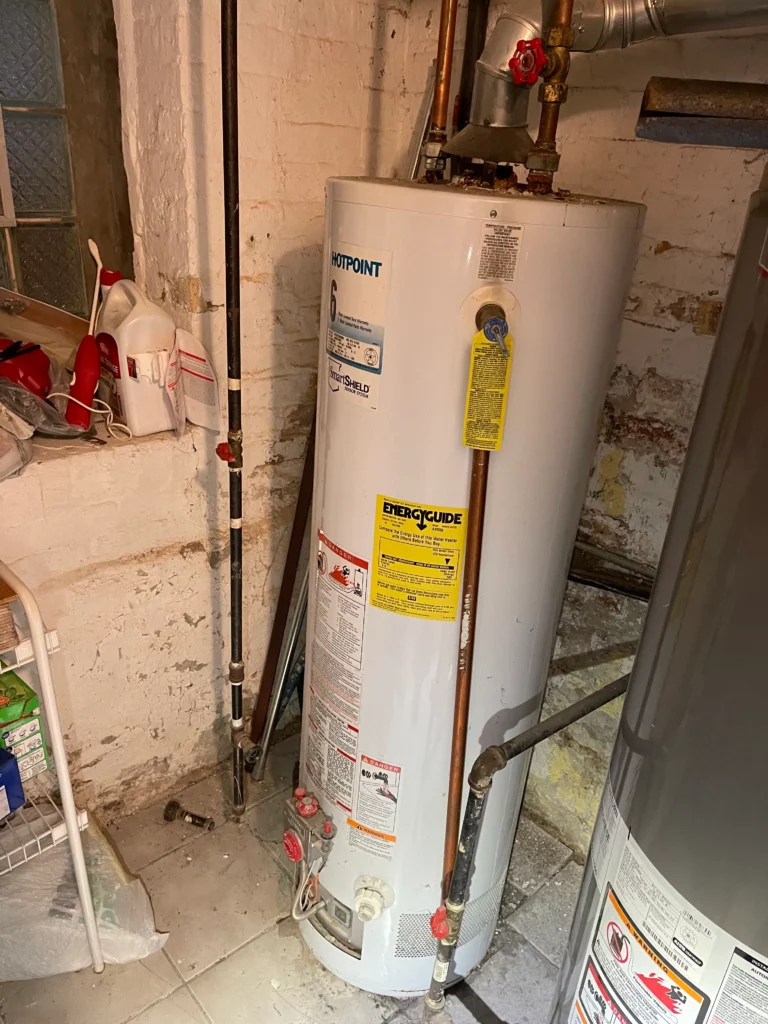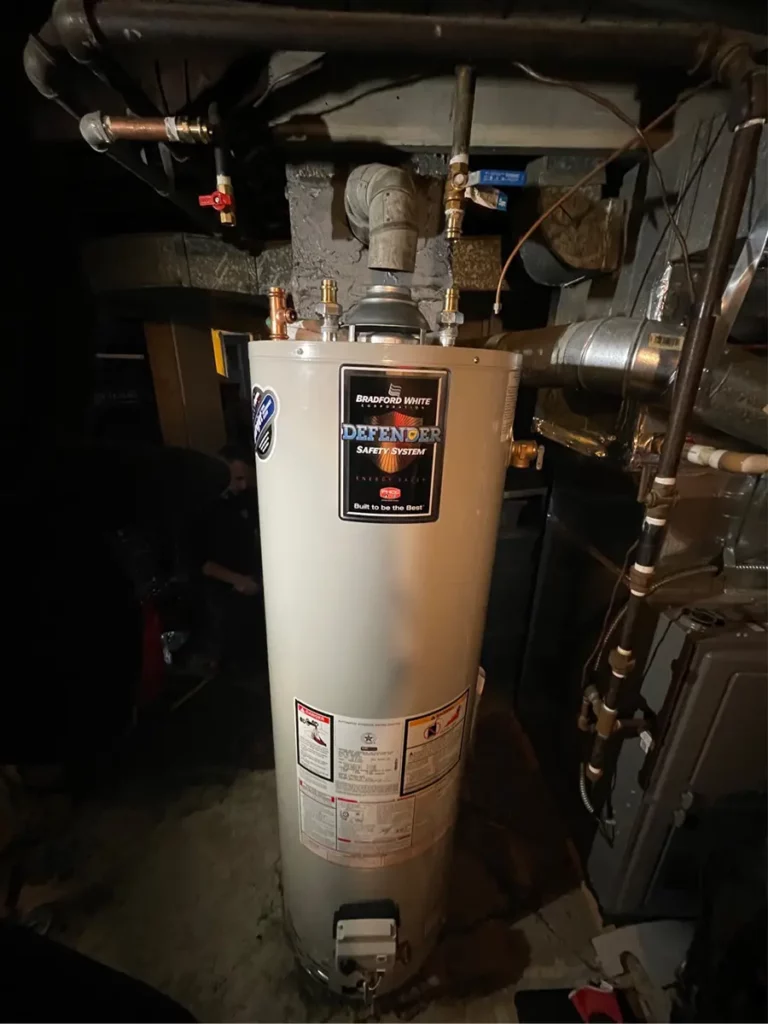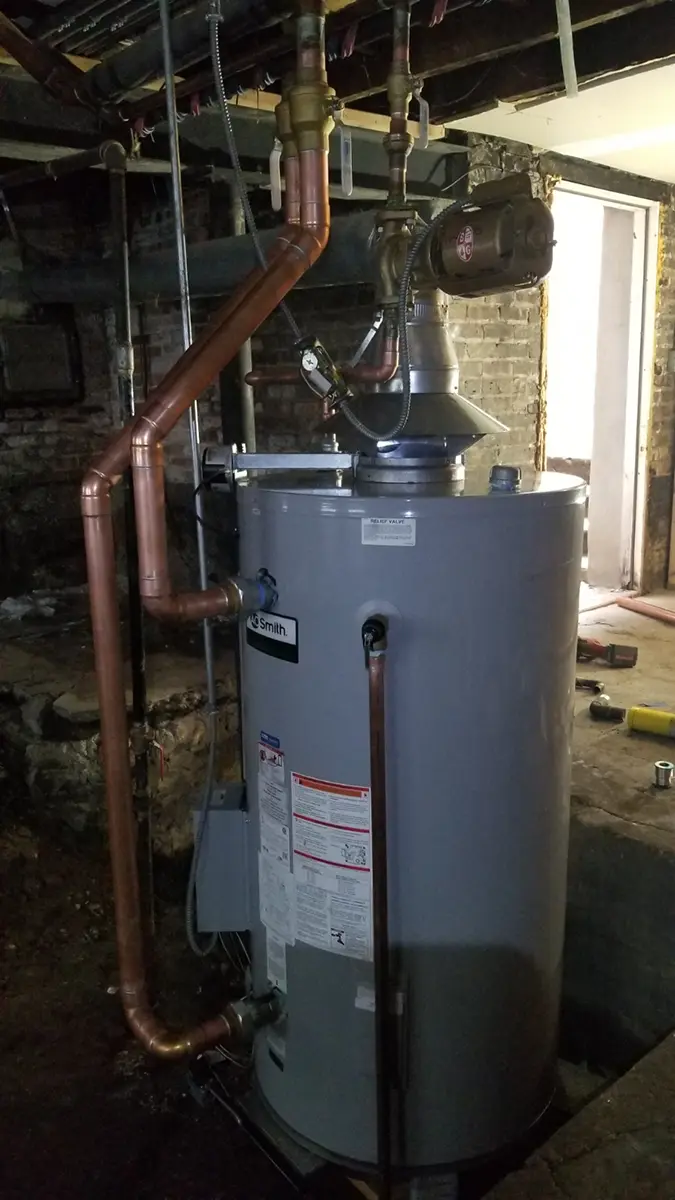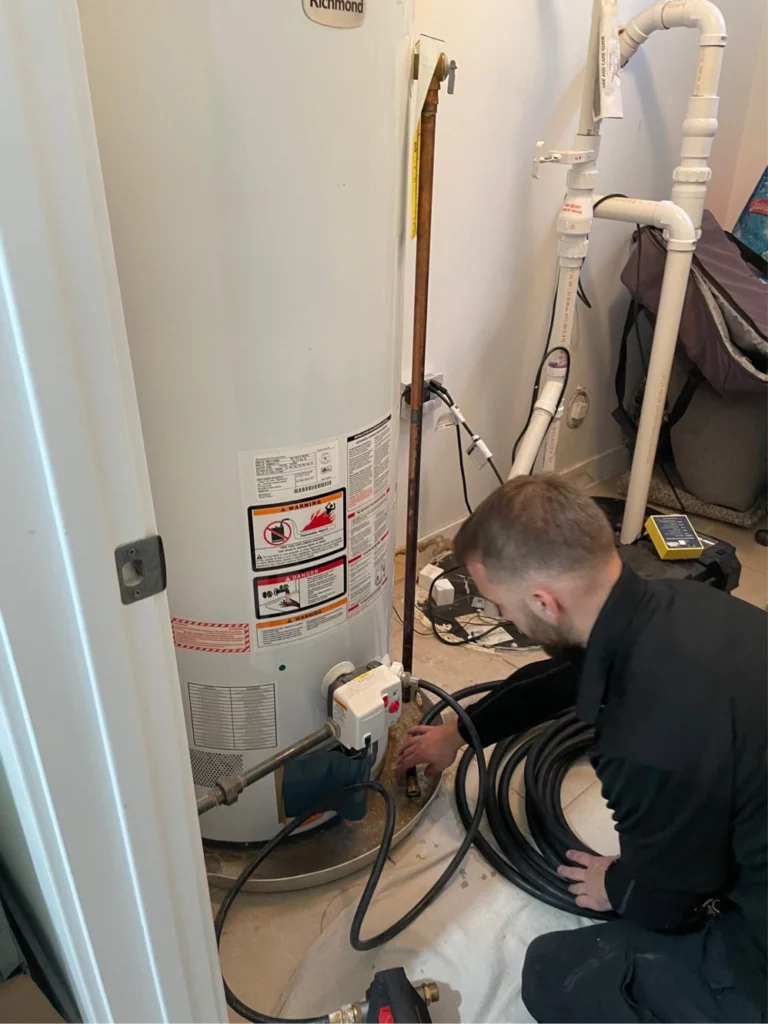Water Heater Not Working? How to Handle Water Heater Repairs Like a Pro
It’s a fact we often take for granted; every American household depends on a hot water heater. Day in and day out, these trusty appliances sanitize our homes, wash our clothes and dishes, and produce heated water for our showers. Yet, how many of us actively maintain our water heaters?
As most people do not even know where their hot water heater is located, it’s safe to assume the answer is very few! But it’s important to recognize the significance of a reliable water heater in our daily lives and take the necessary steps to ensure its longevity.
Key Takeaways
- Regular maintenance of water heaters is crucial for preventative care and to prolong their lifespan, helping to catch minor issues before they escalate into bigger problems.
- While modern water heaters offer enhanced safety features and efficiency, they also present more complexity and potential for failure due to their intricate parts. Understanding their components and maintenance needs is essential.
- Self-troubleshooting common water heater issues can be effective for minor problems, but professional assistance is recommended for more complicated repairs to ensure safety and correct handling.
The Essential Role of Water Heaters
From morning showers to dishwashing, laundry, and even heating your home, hot water heaters play an integral role in our everyday lives. Constantly working behind the scenes, they ensure we have hot water at our disposal whenever we need it.
Yet, like any appliance, they’re subject to wear and tear. The more we use our hot water heater, the more likely it is to develop issues over time, leading to potential failure and those dreaded cold showers.
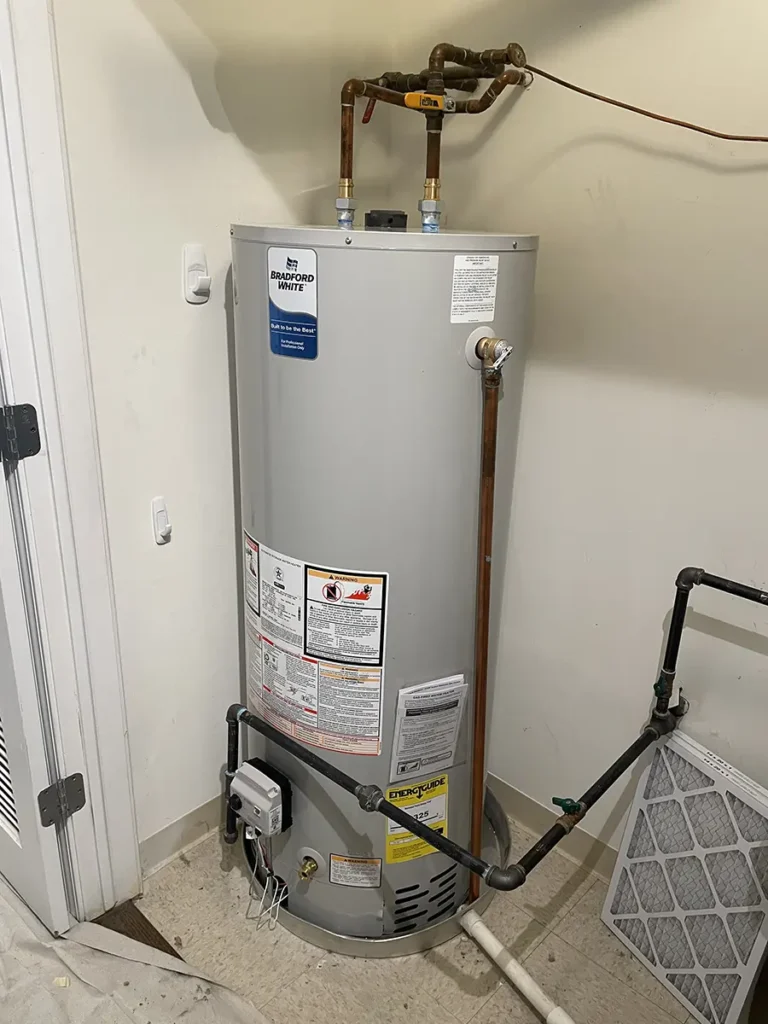
That’s why understanding the critical role of water heater repair services and giving these systems the attention they deserve can keep them running efficiently for years to come.
The Neglected Hero: Water Heater Maintenance
Just like a car requires regular servicing to run efficiently, so does your water heater. It’s easy to forget about this unsung hero when it’s working fine, but neglecting regular maintenance can lead to frequent repairs and a shorter lifespan for your water heater.
By regularly inspecting and cleaning your water heater, you can catch minor issues before they become significant problems, saving you time and money in the long run.
Understanding the Need for Water Heater Repairs
Water heaters are built to last, but they aren’t invincible. With an average lifespan of 8 to 12 years, several factors can influence their durability, including the quality of installation, regular maintenance, and water quality. But no matter how well you take care of your water heater, it will eventually need repairs due to constant use, wear and tear, and the complexity of modern models.
Understanding these factors can help you anticipate and address issues before they turn into significant problems, ensuring uninterrupted access to hot water and the correct temperature.
Constant Use and Wear and Tear
One of the primary reasons for water heater repairs is the inevitable wear and tear. As with any appliance, the more you use your water heater, the more likely it is to develop issues over time. Common problems that arise from regular use include sediment buildup and leaks, which can lead to the need for repairs.
So, while it’s impossible to stop the wear and tear, regular maintenance can help slow it down, prolonging your water heater’s lifespan.
Comparing Longevity: Old vs. Modern Water Heater
Water heaters from 20-30 years ago were built to last longer than today’s models. Back then, appliances were simpler and often lasted beyond their expected service life.
These gas water heaters lasted so long because they didn’t need that many parts to operate. However, laws were implemented through the National Appliance Energy Conservation Act (NAECA) to make water heaters meet pollution and efficiency standards, which led to water heaters needing more functioning parts.
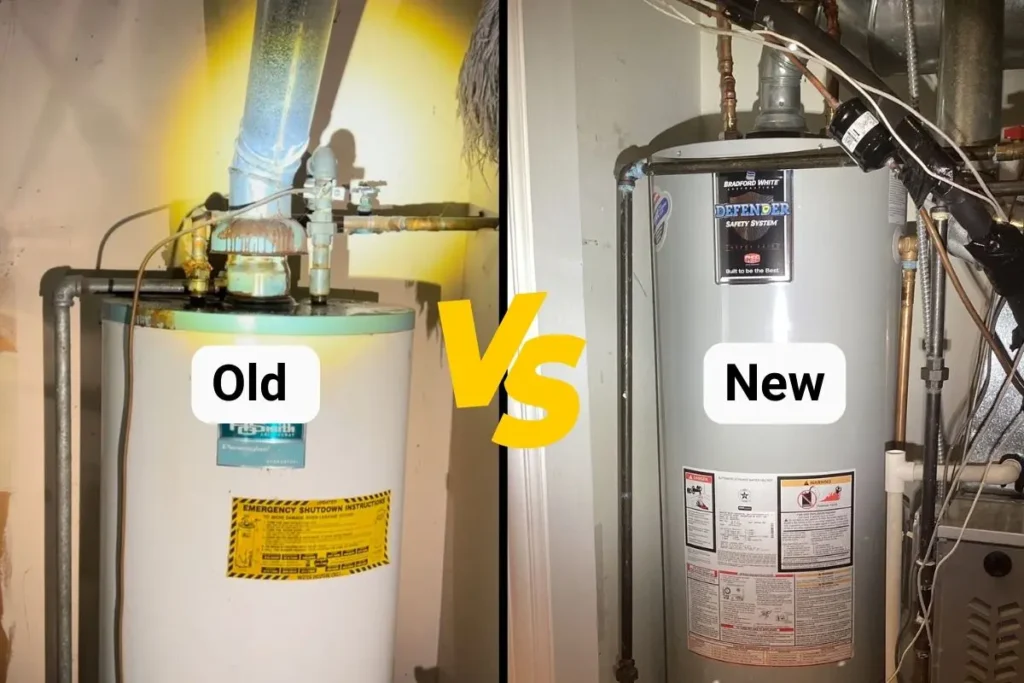
Since modern water heaters are now packed with numerous parts for safety features and efficiency standards, they can sometimes fail within their average lifespan due to various issues such as:
- Leaks
- Corrosion
- Sediment buildup
- Pressure valve issues
- Faulty water heater thermostat
It’s important to regularly inspect your water heater to ensure its longevity and efficiency.
Complexity and Parts: The Modern Water Heater Challenge
While the advancements in modern and electric hot water heaters have improved efficiency and safety, they’ve also introduced a new challenge: complexity. Modern electric water heaters are equipped with numerous parts, including computer chips, pressure sensors, and other safety features. This complexity increases the likelihood of failures and the need for repairs.
Understanding these components and their potential issues can help you troubleshoot problems and ensure your water heater runs smoothly.
How to Identify Water Heater Problems
When your hot shower suddenly turns cold and there’s not enough hot water, it’s a clear sign something’s wrong. But how can you tell if the problem lies with your water heater or another part of your plumbing system? It’s easier than you might think. From checking the hot water temperature and listening for unusual noises to investigating leaks, you can often identify the cause of the issue yourself.
While some minor problems can be resolved by homeowners, others might require the need for a professional. For now, let’s dive into how you can identify common water heater problems.
Simple Steps to Check for Hot Water
If your property has a lack of hot water, the first step is to check all the faucets in your home. If none of them are producing hot water, it’s likely the heating element in your water heater is the culprit. But before jumping to conclusions, it’s also worth considering other factors, such as:
- The size of your water heater: If it’s an undersized tank for your household’s demand, you might experience a lack of hot water.
- The age of your water heater: If it’s old and worn out, it may not be able to heat water effectively.
- Any recent changes or repairs to your plumbing system: This could have affected the flow of your hot water faucet.
If your water heater seems to be fine and there is still no hot water, the only other reason for no hot water is a broken water heater tempering valve.
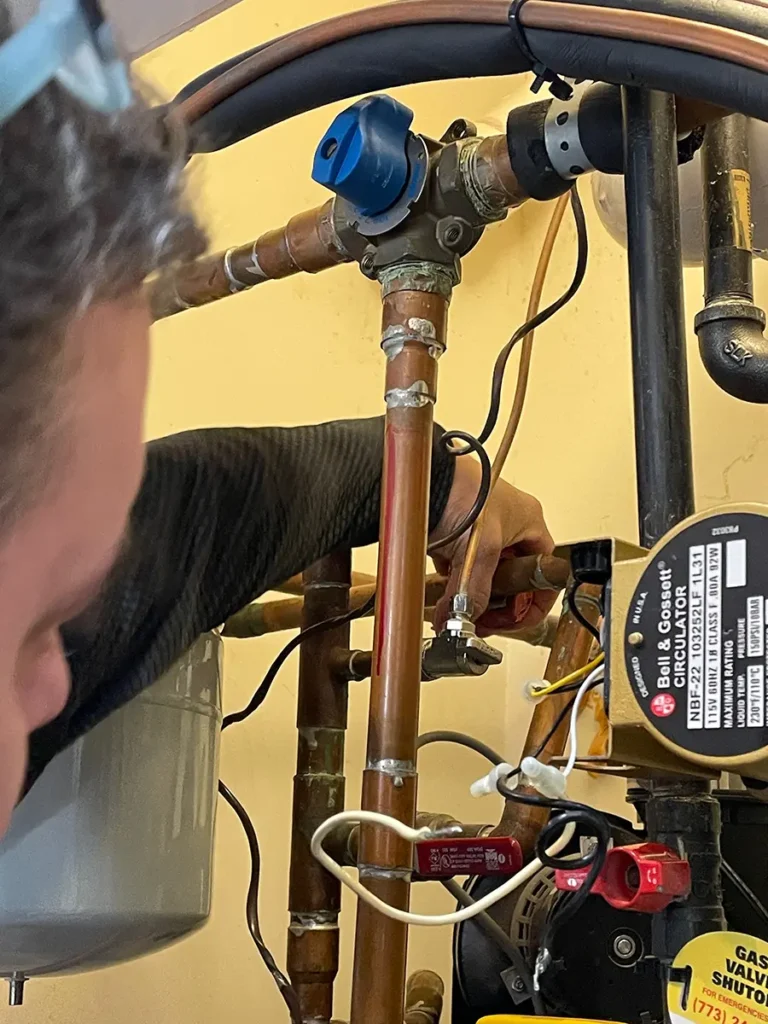
This is an extra part separately installed to the water heater that could affect the heating elements. If that is the case, you would need to repair this part before evaluating anything else wrong with the heater.
When Noises and Leaks Cause Panic
Noises and leaks from gas or electric heaters can be alarming. But before you panic, it’s important to understand that these are common issues that don’t always indicate a serious problem.
For instance, rumbling or popping noises can be caused by sediment buildup and boiling water at the bottom of the tank, while leaks may be due to high pressure affecting the tubes or pipes and their connection points. So while these issues may require attention, they’re not always a cause for concern.
The Truth About Water Heater Noises
Let’s talk about the elephant in the room. Or rather, the water heater in the basement. Yes, water heaters make noise. It’s perfectly normal due to the moving parts inside them. So, if you hear some sounds coming from your water heater, don’t panic—it’s usually not a cause for concern.
Just like a humming fridge or a whirring fan, your water heater is simply doing its job.
Identifying Leaks: Pipes vs. Tank
Leaks are another common concern for water heater owners. But not all leaks are created equal. If water is pooling at the bottom of your water heater, it may indicate an internal tank leak due to sediment buildup and corrosion, which typically requires tank replacement.
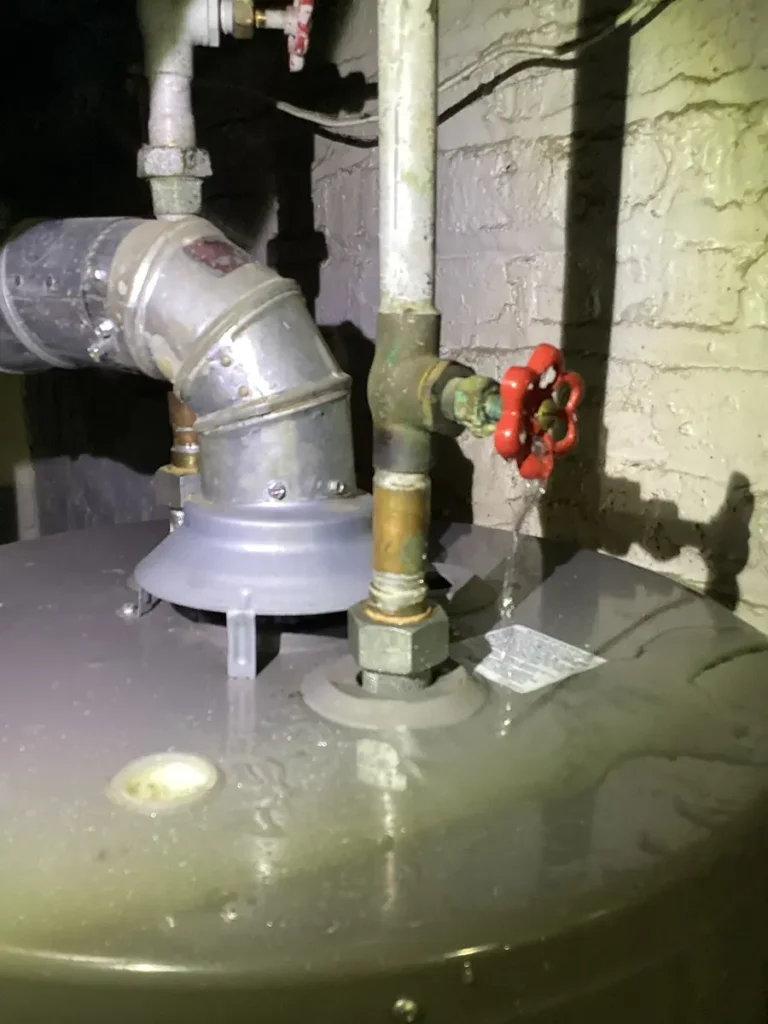
To check if leaks occur from the tank, install a water heater gauge to the boiler drain valve on the water heater tank. Once this is installed, leave the heater alone for 15 minutes to see if the pressure changes.

If the pressure doesn’t change, then the tank is not the problem! However, if the pressure drops, your water heater has a leak and needs to be replaced.
On the other hand, leaks at the top of the water heater may occur where water enters and exits due to high pressure affecting the tubes or pipes and their connection points. Understanding the source of the leak, whether it’s related to gas leaks or water issues, can help you take the appropriate action.
Quick Fixes and Hacks for Common Water Heater Issues
Like any homeowner, you probably want to avoid any water heater repair whenever possible. The good news is that there are several quick fixes and hacks you can try to resolve common water heater failure issues.
Whether it’s relighting your water heater, cleaning the thermocouple, or dealing with a faulty thermopile, these DIY solutions can often get your water heater up and running again in no time. Remember, though, these are temporary fixes. For long-term peace of mind, it’s always best to consult a professional.
Relighting Your Gas Water Heater
If your water heater has gone out cold, it may simply need to be relit. While this might sound daunting, it’s a straightforward task that you can often do yourself.
To check if your water heater needs to be relit, touch the two pipes above the water heater. The pipe marked ‘INLET’ should be the cold pipe, and the pipe marked ‘OUTLET’ should be the warm pipe. Careful touching the ‘OUTLET’ pipe, the heating element could make the pipe too hot and potentially burn you!
If the ‘OUTLET’ pipe is not warm, then your water heater needs to be relit.
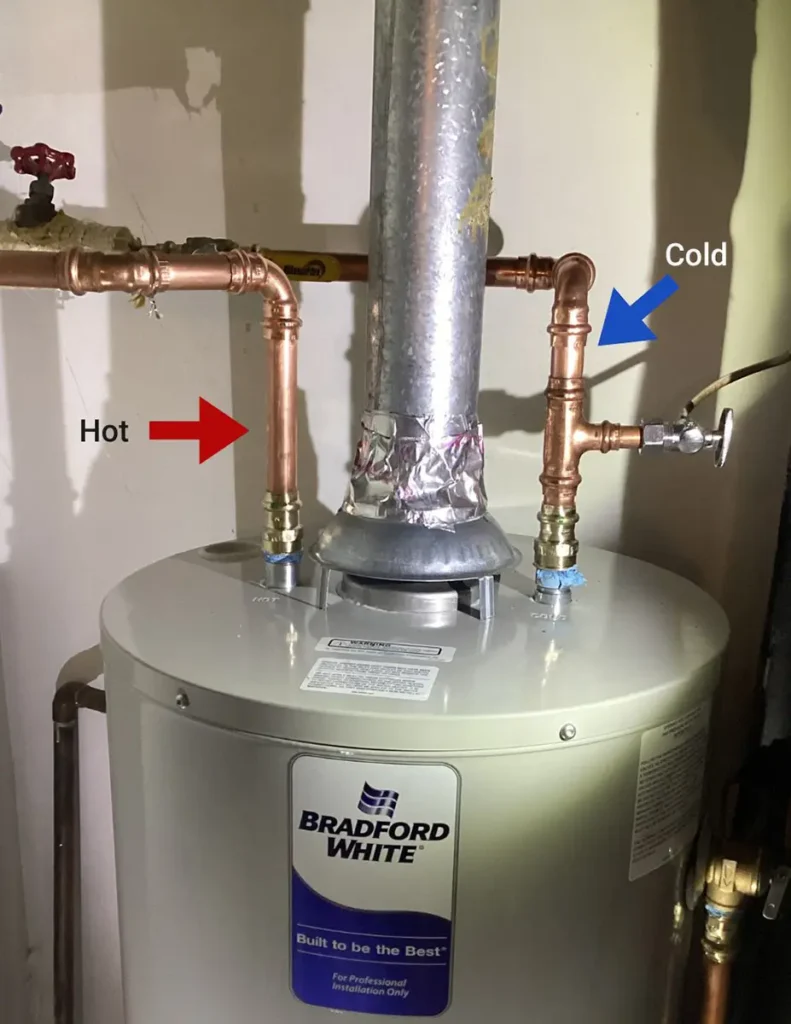
To relight your water heater, follow these steps:
- Ensure Safety First: Before you start, make sure to locate the gas valve and turn it to the “OFF” position. Allow any residual gas to dissipate for about five to ten minutes.
- Access the Pilot Light: Depending on your water heater model, you may need to remove a panel at the bottom. This will give you access to the pilot light and burner assembly.
- Locate the Pilot and Igniter: Find the pilot light and the igniter button, which is usually red or black. If your water heater doesn’t have an igniter button, you will need a long-reach lighter.
- Turn the Gas Valve to ‘Pilot’: Rotate the gas valve from the “off” position to the “pilot” position. This primes the pilot light and allows gas to flow when ignited.
- Ignite the Pilot Light: Hold down the pilot valve button and press the igniter button or use your long-reach lighter to ignite the pilot light. Keep the pilot valve button pressed for about 30 seconds after the pilot light ignites to ensure it stays lit.
- Verify the Pilot Light Stays Lit: After releasing the pilot button, the light should remain on. If it goes out, you may need to repeat the previous step or check for any issues such as dirt in the pilot or problems with the thermocouple.
- Turn the Gas Valve to ‘On’: Once the pilot light is reliably lit, turn the gas valve to the “on” position. Replace any panels or covers that were removed.
- Check Operation: Monitor your water heater to ensure it’s functioning properly and that the main burner ignites when the thermostat calls for heat.
By following these instructions or consulting one of our professionals here at Rescue Plumbing, you can safely relight your hot water heater and restore your hot water supply.
Remember, safety comes first! If you’re unsure about any step in the process, it’s always best to call in a professional.
Cleaning the Thermocouple or Thermo-Pile
For older water heaters, a common issue is a dirty thermocouple. This small but vital component is responsible for keeping your water heater’s gas supply running. Over time, it can get covered in soot, preventing it from working correctly.
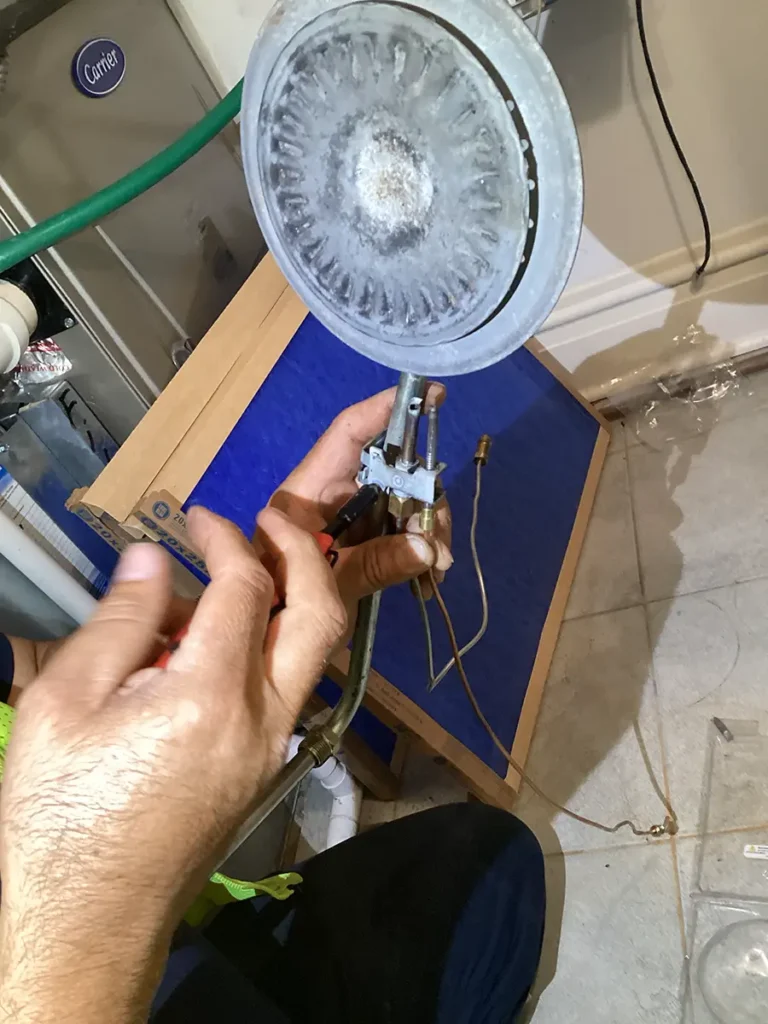
But don’t worry—a quick clean with fine sandpaper or a crisp dollar bill can often get your thermocouple working again, restoring your hot water supply. Be sure to remove the thermocouple from the system before cleaning!
Thermo-Pile Cleaning: Keeping Your Heater Running Smoothly
Just like the thermocouple in older models, modern water heaters use a thermo-pile as their upper heating element. This component acts as a thermo-coupler, converting heat into electricity, and is more powerful than a thermo-couple.
Over time, it can get dirty, affecting its performance. But a quick clean with a Brillo pad can often get your thermo-pile working again, ensuring your water heater runs smoothly. Unlike thermocouples, you need a thicker cleaning pad, such as steel wool or a heavy-duty scouring pad.
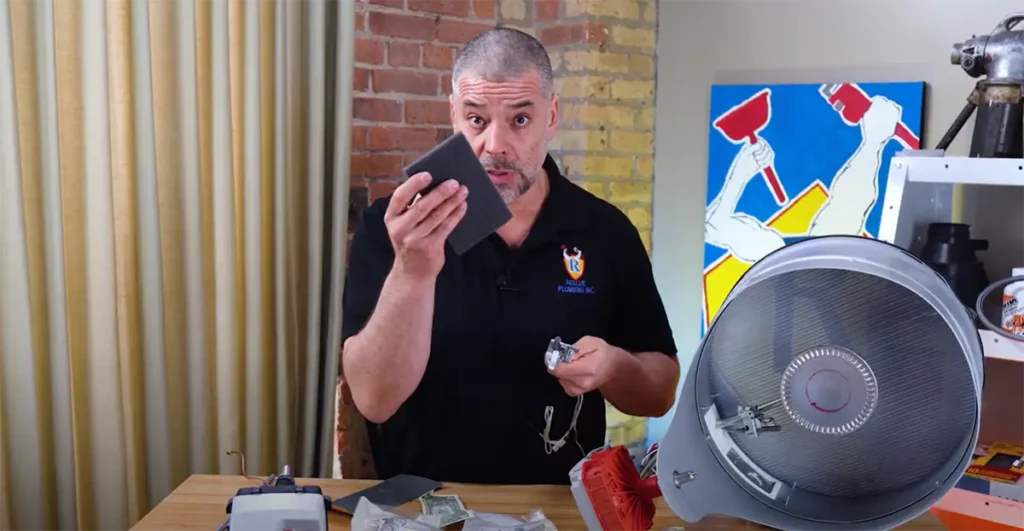
Before you start cleaning either your thermocouple or thermo-pile, make sure to turn off the gas supply and turn off the power source from your water heater. Once you’ve taken these necessary precautions, simply remove the thermocouple or thermo-pile from the water heater and gently scrub it with your chosen cleaning pad. Be sure not to use anything too abrasive that could damage the delicate components.
After cleaning, reattach the thermo-pile to the water heater and reconnect all power sources. Turn on the gas supply again and test your hot water supply. If everything is working properly, then congratulations – you have successfully cleaned your thermo-pile!
After you clean and reinstall it, make sure to completely close the combustion chamber. If the chamber isn’t closed all of the way and sealed properly, your water heater won’t work.
Thermo-Pile Repairs For New Water Heaters
Sometimes, despite your best cleaning efforts, your water heater might still have heating element issues and will need to replace your thermocouple or thermo-pile.
While this might sound complicated, it’s a relatively straightforward process. If you’re unsure about anything, it’s always best to call in a professional to avoid damaging your water heater or injuring yourself.
Key Water Heater Parts and Their Repairs
Water heaters might seem complicated with their various parts and components, but understanding these heating elements can make it easier to maintain and repair your appliance. Knowing what each part does and how it can fail allows you to troubleshoot problems and even perform some repairs yourself.
From the igniter assembly and gas valve to the blower motor limit switch and flammable vapor sensor, each part plays a crucial role in the operation of your water heater.
Igniter Assembly: The Heart of Your Water Heater
The igniter assembly is like the heart of your water heater. It’s the heating element that gives the initial spark to turn on the water heater. Due to its significant role and constant use, it’s the most common part to fail on all water heaters.
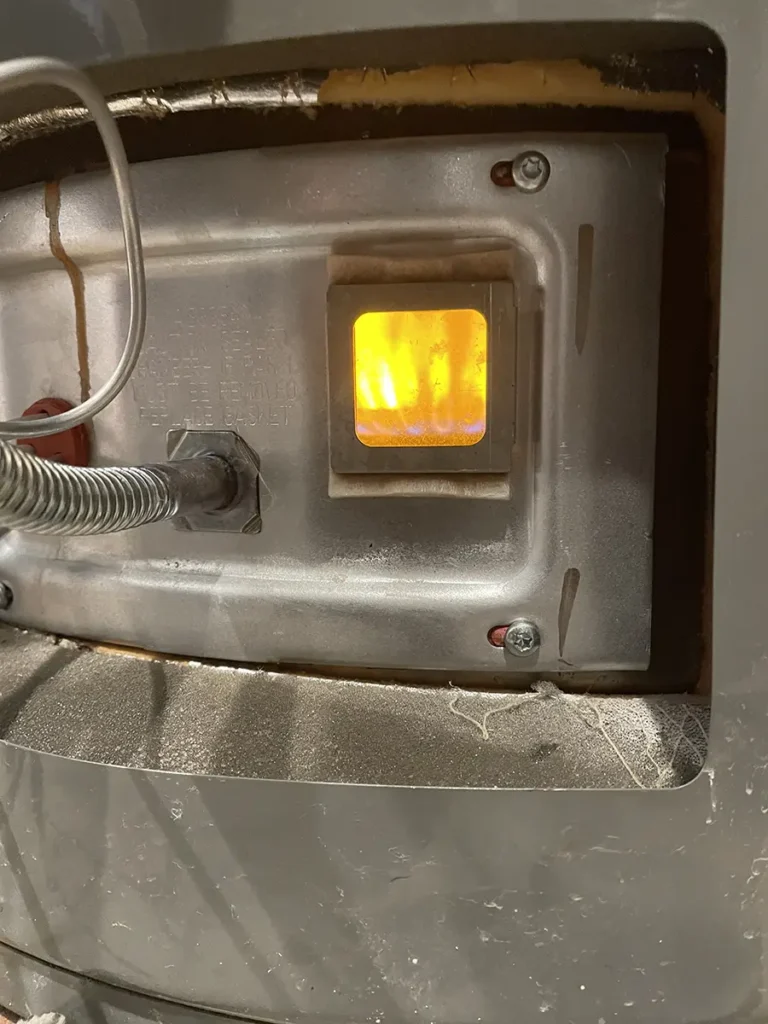
But don’t worry, there’s a simple solution. By keeping a spare igniter assembly on hand, you can quickly replace it when necessary, preventing unexpected cold showers.
Gas Valve Replacement
The gas valve is another common point of failure in a gas water heater, which can lead to water heater failure. This component is responsible for controlling the flow of gas to your water heater, and if it’s not working correctly, your water heater won’t heat up.
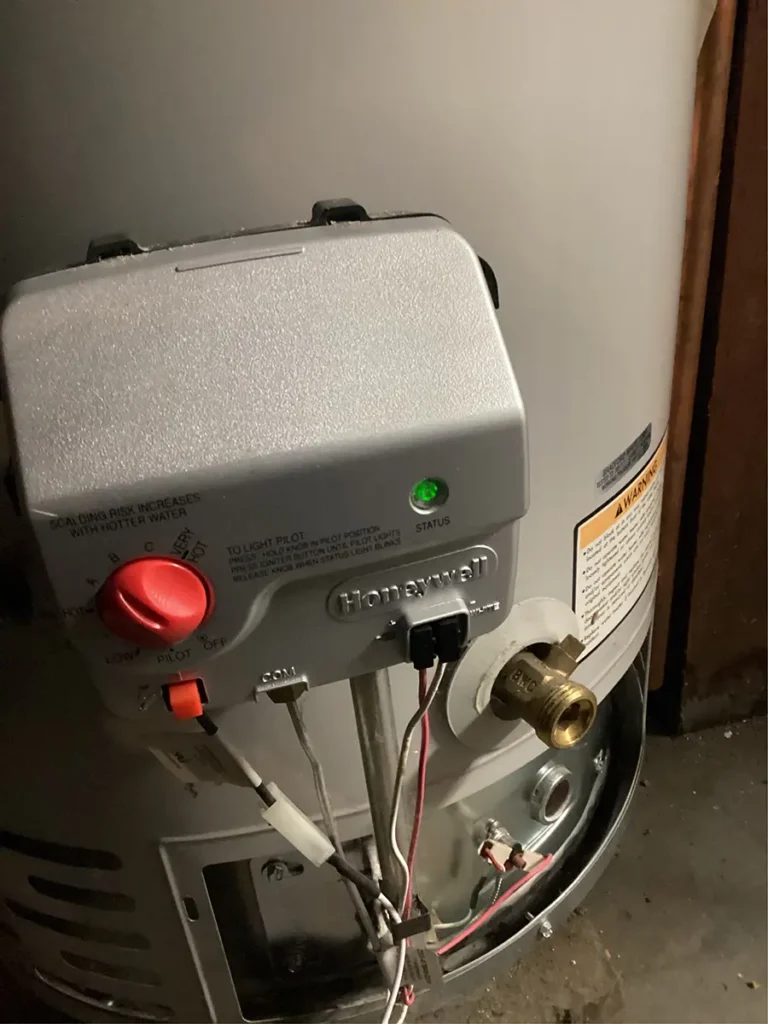
While it’s possible to replace a faulty gas valve, this task is better handled by the professionals. These components, including the drain valve, are delicate and expensive, so it’s often best to consult a professional for repairs or replacements.
Blower Motor Limit Switch: Quick Fixes for Common Failures
A common issue with power-vented water heaters is a failed blower motor, usually due to the pressure limit switch sensor or a faulty circuit breaker. This sensor is responsible for detecting any back pressure in the water heater’s flue pipes and can stop your blower motor from working if it fails.
Luckily, replacing the limit switch is a quick fix and you can order this part online. Not a lot of plumbing stores have this part in-store.
Flammable Vapor Sensor: Keeping Your Home Safe
Finally, let’s talk about safety. Some modern gas and electric water heater brands come equipped with a flammable vapor sensor. This essential safety feature detects hazardous vapors and shuts down the water heater to prevent accidents. If your sensor is triggered, you’ll need to replace it to restore your water heater’s functionality.
However, sometimes this sensor can be triggered by the strong odors from paint and cat pee. If this is the case, you can replace the sensor and your problem will be solved! For any paint-related jobs, be sure to add a sealing agent to the surface of the dried painted area before replacing the vapor sensor.
Navigating the World of Water Heater Parts
With so many different water heaters on the market today, it can be overwhelming to navigate the world of heating element parts. Each model has unique components that can evolve and change over time, often due to recalls and updates from the manufacturer. This constant evolution can make it challenging to find the right parts for your water heater.
Batch Production and Recalls: How Water Heater Parts Evolve
Water heater parts are produced in batches, and when a batch of water heaters has a common flaw, manufacturers issue recalls to fix the issue. This system ensures that newer models are improved and less likely to have the same issues.
However, navigating these recalls can be challenging, especially when they’re put on hold, like during the recent pandemic. As a result, some water heater repairs may require full replacements instead of just replacing the faulty part.
Prolonging Your Water Heater’s Life with Preventative Maintenance
With the right care and maintenance, your water heater can serve you well for many years. Regular maintenance not only extends your water heater’s lifespan but also ensures it operates at peak efficiency. Here are some key maintenance tasks to keep in mind:
- Insulate the tank to improve energy efficiency
- Check for leaks and repair any issues promptly
- Clean the combustion chamber to ensure proper functioning
- Test the pressure relief valve to ensure it is working correctly
- Drain the tank using the drain valve and flush out sediment regularly to prevent buildup
By performing these maintenance tasks regularly, you can prevent minor issues from becoming major problems and save money on repair and replacement costs in the long run.
Tankless Water Heater Maintenance: Detailed Procedure
Tankless water heaters, on the other hand, require a more invasive procedure for maintenance. This includes using a recirculation pump and a vinegar-type cleaning fluid to remove buildup and maintain efficiency. Regular flushing and inspection of the inlet filters are also crucial to prevent debris buildup and ensure the longevity and efficiency of your tankless water heater.
To do this, you hook up the recirculation pump and then run your cleaning fluid through this pump for an hour. Performing this yearly maintenance is the best chance you have to prolong your water heater unit.
Choosing the Best Water Heater for Your Home
Choosing the right gas or electric water heaters for your home can be a daunting task with so many options available. There are so many factors to consider, like the system’s capacity to meet your family’s needs, its energy efficiency, and the type and size appropriate for your home’s fuel source. Although this may seem like a daunting task, we’re here to help!
Why We Recommend Bradford White Water Heaters
Bradford White water heaters are known for their energy efficiency and for being environmentally friendly with “Energy Star” certification. They are reliable and have fewer issues compared to other brands.
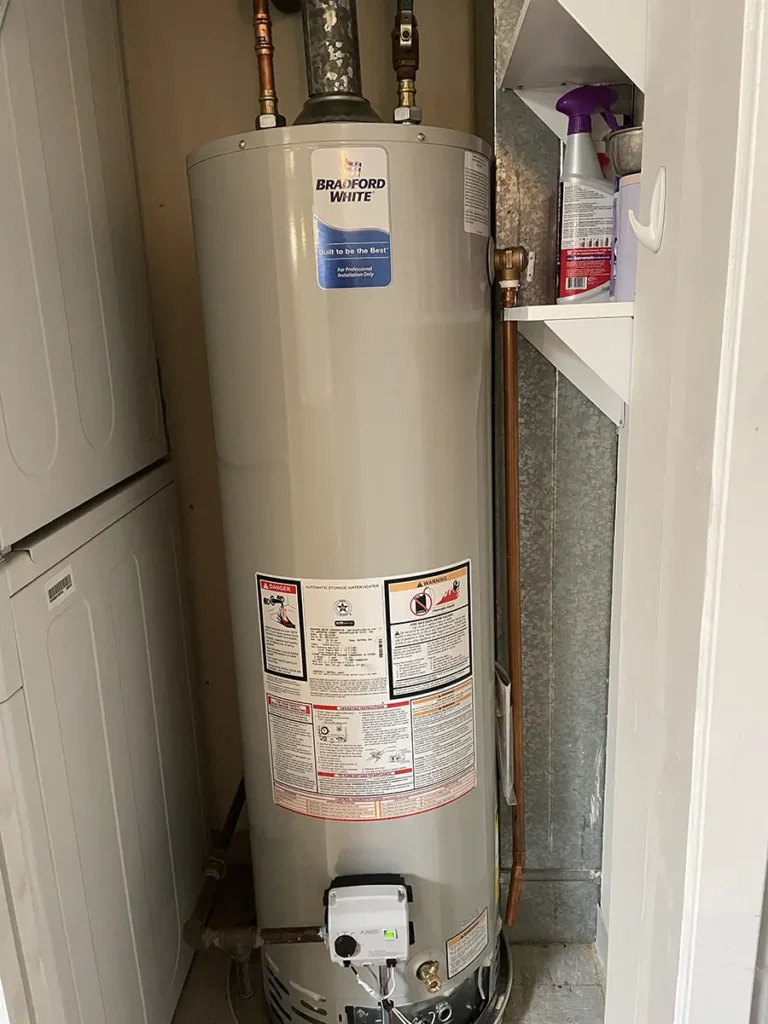
When problems do arise, we’ve found that Ferguson Plumbing Supply provides excellent support. So, whether you’re replacing an old water heater or installing one in a new home, we highly recommend Bradford White water heaters.
Let Rescue Plumbing Handle Your Gas or Electric Water Heater Repair
At Rescue Plumbing, we’re not just about selling water heaters—we’re committed to providing top-notch repair services too. Our team is trained to repair any gas or electric water heater we install, ensuring you receive the best service and customer satisfaction.
We offer a full spectrum of 24-hour plumbing services, including emergency solutions and residential plumbing maintenance. Our team of highly trained professionals is equipped to handle a variety of water heater issues, often providing same-day service.
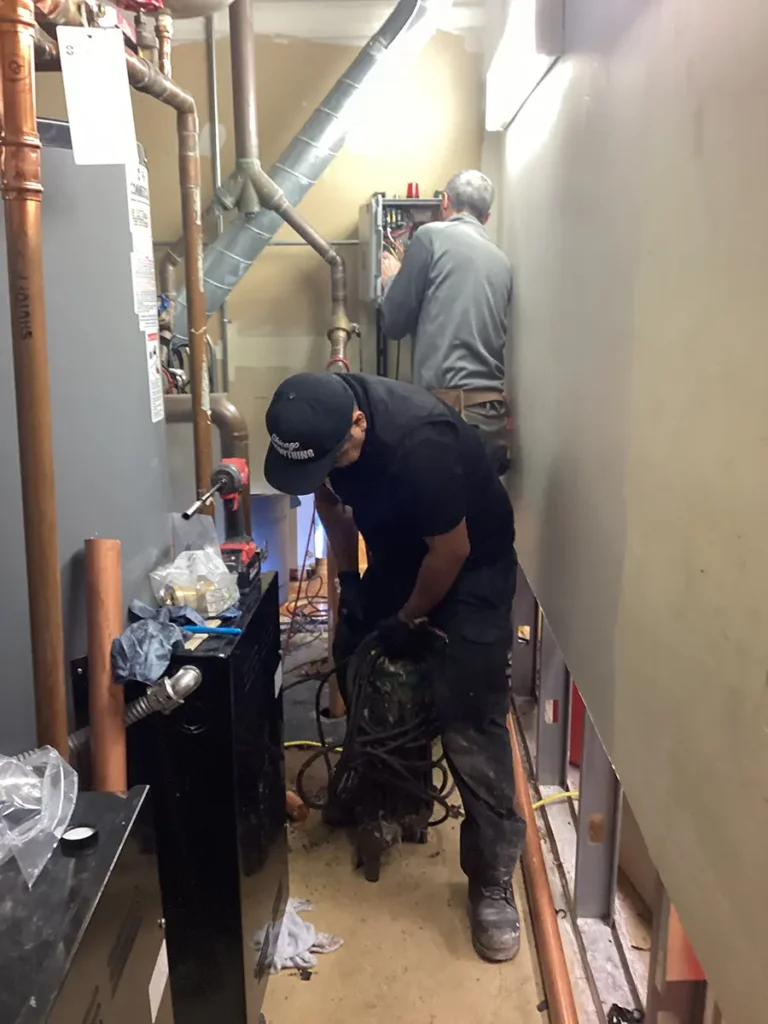
Dealing with water heater issues can be stressful. That’s why Rescue Plumbing offers free in-person estimates, ensuring transparency and no surprise charges for our customers.
So, whether your water heater is making strange noises, the water temperature is cold, the system has sprung a leak at the bottom of the tank, or needs yearly maintenance, we’ve got you covered. Give us a call at 773-799-8848 for any water heater troubles and schedule service today!
Summary
Water heaters play a crucial role in our daily lives, providing hot water for a range of activities. However, like any appliance, they require regular maintenance to function efficiently and last longer. By understanding the common issues that can arise with a gas or electric water heater and learning how to address them, you can ensure your water heater runs smoothly for years to come.
If you ever run into any problems, don’t hesitate to contact a professional like Rescue Plumbing. After all, there’s nothing quite like a warm, relaxing shower at the end of a long day.


